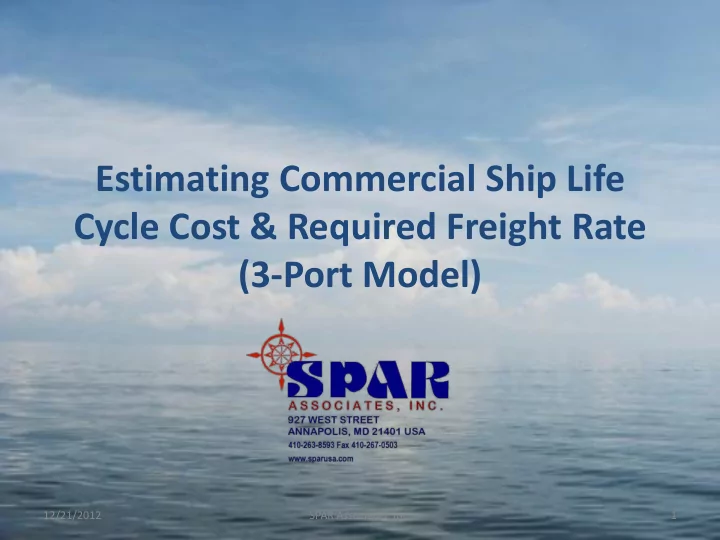

Estimating Commercial Ship Life Cycle Cost & Required Freight Rate (3-Port Model) 12/21/2012 SPAR Associates, Inc. 1
This is another of SPAR’s ESTI-MATE Cost Models. It focuses on life cycle costs for commercial ships and estimating the required freight rates for a user-defined trade route and operational characteristics. For the life cycle costs, annual estimates are generated for • Capital financing and return on equity; • Salvage/resale • Insurance • Administration • Supplies and crew When the user defines details of the trade route (average voyage scenario of speeds and distances), the Cost Model estimates costs for • Fuel • Port & drayage. The Cost Model develops the Required Freight Rate (RFR) on the basis of unit (trailer, TEU, passenger, etc.) voyage cost, tonnage, and/or equivalent statute land miles (if applicable). 12/21/2012 SPAR Associates, Inc. 2
Typical Breakdown of Annual Costs for a High-Speed Commercial Trailer Ship Capital Cost Return on Equity 2.7% 2.8% 0.9% 1.5% 3.4% Fuel Cost 16.5% 11.8% Crew Cost 9.4% Port & Handling Costs 8.6% Door-to-Dock Drayage Tranport Costs 6.9% 35.4% Insurance Maintenance & Repairs Management Costs Lubes, Oils & Stores Other 12/21/2012 SPAR Associates, Inc. 3
Basic Hierarchy of Life Cycle Costs 12/21/2012 SPAR Associates, Inc. 4
Defining Transit Route Distance per Leg of the Route 5 12/21/2012 SPAR Associates, Inc.
Defining Transit Route Speed per Leg of the Route 12/21/2012 SPAR Associates, Inc. 6
Defining Transit Route Time in Hours per Leg of the Route 12/21/2012 SPAR Associates, Inc. 7
Defining Transit Route Fuel Consumption per Leg of the Route 12/21/2012 SPAR Associates, Inc. 8
Defining Basic Components of Capital Cost 12/21/2012 SPAR Associates, Inc. 9
12/21/2012 SPAR Associates, Inc. 10
12/21/2012 SPAR Associates, Inc. 11
12/21/2012 SPAR Associates, Inc. 12
Comparing Financing Terms $16.00 Millions Equal Annual Pmt of Principle + Interest on Rem. Principle Equal Annual Pmt Mortgage $14.00 Equity Return $12.00 $10.00 Annual Cost of Money $8.00 $6.00 $4.00 $2.00 $- 1 2 3 4 5 6 7 8 9 10 11 12 13 14 15 16 17 18 19 20 21 22 23 24 25 Years for Financing 12/21/2012 SPAR Associates, Inc. 13
12/21/2012 SPAR Associates, Inc. 14
Estimating Propulsion Power Curve 80,000 70,000 y = 20.35477x 2 + 42.40645x - 854.24061 Estimated Propulsion Power (kW) 60,000 R² = 0.99912 50,000 40,000 30,000 20,000 10,000 - 0 10 20 30 40 50 60 70 Speed (KTS) 12/21/2012 SPAR Associates, Inc. 15
12/21/2012 SPAR Associates, Inc. 16
12/21/2012 SPAR Associates, Inc. 17
12/21/2012 SPAR Associates, Inc. 18
There are three methods for determining fuel consumption in metric tons for each leg of the trade route. 1. The first method allows entries of estimate kW expended each leg (including electric generation in port) for each (if multiple) propulsion system for the ship. The cost model computes the tons of fuel consumed by multiplying the kW by the leg hours and the specific fuel consumption coefficient (SFC). 2. The second method estimates the propulsion kW based on the speed. The “Power Curve” worksheet builds an approximate second order speed -power curve (Figure 3.1- 4) using the ship design’s maximum kW propulsion power versus maximum hull speed. This method most likely cannot develop an accurate kW for the transit leg speed if there are multiple propulsion systems in use. A manual entry for the specific fuel consumption coefficient is required for the model to compute tones consumed over the hours of operation over the transit leg period of time. 3. The third method allows the tons of fuel consumption to be computed off-line from the cost model and entered in the gray cell labeled “Manually Entered Propulsion Fuel MTONs.” 12/21/2012 SPAR Associates, Inc. 19
Summary of 3-Port Voyage 12/21/2012 SPAR Associates, Inc. 20
Summary of Cargo Transfers 12/21/2012 SPAR Associates, Inc. 21
The Cost Model Generates a Variety of Tabular & Graphical Reports 12/21/2012 SPAR Associates, Inc. 22
Report Indicating Required Freight Rates per Type of Cargo Transported 12/21/2012 SPAR Associates, Inc. 23
12/21/2012 SPAR Associates, Inc. 24
12/21/2012 SPAR Associates, Inc. 25
12/21/2012 SPAR Associates, Inc. 26
12/21/2012 SPAR Associates, Inc. 27
12/21/2012 SPAR Associates, Inc. 28
User Caution Users of a cost model are cautioned that it is intended to provide only an estimate of cost information. There are limits to the capabilities of these calculations beyond which results may not be accurate. The data provided in the cost model is not a substitute for judgment, analysis and sound estimating practice. The cost model is an aid in developing an informed opinion of cost. If you are using the cost model as your sole cost authority for contract bids, you are reading more into the cost model than what has been intended. SPAR ASSOCIATES, INC. MAKES NO WARRANTIES OF ANY KIND WITH REGARD TO THIS MATERIAL, INCLUDING, BUT NOT LIMITED TO, THE IMPLIED WARRANTIES OF MERCHANTIBILITY AND FITNESS FOR A PARTICULAR PURPOSE. SPAR Associates, Inc. shall not be liable for errors contained herein or for incidental or consequential damages in connection with the furnishings, performance or use of this material. 12/21/2012 SPAR Associates, Inc. 29
Over 40 Years Serving the Shipbuilding & Repair Industry 12/21/2012 SPAR Associates, Inc. 30
Recommend
More recommend